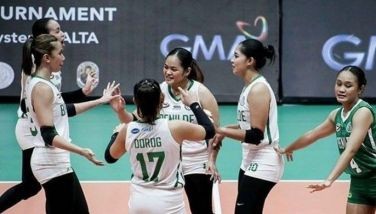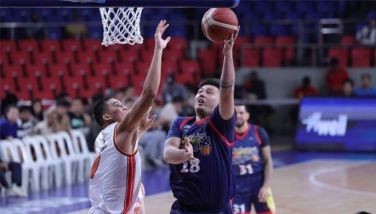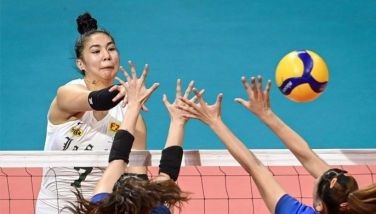The national team conundrum
It’s always a mistake to make gods out of men, yes. But it’s equally wrong to make devils. We shouldn’t deify people just because they made the things we love, true. But we also shouldn’t be ready to write them off just because they don’t live up to their deification. – Bob Chipman, “The Big Picture”
There have been a lot of mixed emotions about the way Gilas Pilipinas was treated by China in last weekend’s FIBA-Asia finals, which cost the Philippines an outright Olympic basketball berth. Back home, questions and loud opinions have been voiced about whether or not the country should even send a team to the wild card tournament next year, or if a PBA team can be gouged out of PBA regular-season play to form the nucleus of the next Philippine team. This writer believes we are not looking at the root of the problem: the system is broken.
Let’s look back at our own basketball history. From 1938 onwards, the Manila Inter-Commercial Athletic Association (MICAA) was the only commercial game in town. The players were essentially employees, but were also the best players in the country, veterans of the top collegiate basketball teams not just in what is now Metro Manila, but around the country. This was the playground of the rich, bragging rights for whoever was either basketball champion or overall champion, and one was often the other, as well.
What happened and caused the birth of the PBA? The Basketball Association of the Philippines (BAP) at the time developed a nasty habit of borrowing players from the strongest MICAA teams, then conveniently forgot to return them. One MICAA team owner said that they only got their players back when they were either injured or otherwise too beat up to play. One future PBA legend said that he was never able to suit up for his champion mother team at all in 1974. That caused all but one of the team owners to rebel and form a professional league. In the pre-open basketball era, their players would now be untouchable, since pros then were not allowed in international competition. The last remaining team, having nobody left to play against, likewise jumped ship, sounding the death knell for the MICAA.
So you see, the problem is not a new one. But to be very clear, the purpose of the PBA’s existence is to showcase basketball as entertainment and promote their member teams’ companies’ products. Period. That has always been its raison d’etre, its reason for being. It was only with the advent of open basketball in the Asian Games in 1990 that the BAP persuaded the league to send an all-pro team (which first saw action in international competition months before the original US Dream Team did). Since then, there have been selections formed as national teams for the lower-rung tournaments like the SEABA and Southeast Asian Games. Prior to the Samahang Basketbol ng Pilipinas, the last gallant attempt was the Cebuana Lhuillier Philippine men’s team. And we all know how that went. Even the best-intentioned efforts can be polluted by politics.
How did the demise of that team come about? A meaningless pre-season tournament of a now-defunct regional league. Before the start of the weeklong competition, the squad’s starting center Ricky Calimag was picked up by a PBA team. Its starting point guard Egay Echavez was then hired by another PBA franchise. Another point guard was on his honeymoon, and a third sprained his ankle severely in their opening game. Still, Cebuana Lhuillier-Philippines was beating everyone by a double-figure margin. In the finals, their opponents, funded by a local government, (and fielding some ex-pros) started playing dirty and won. There were then negative comments about the national team and actual lies broadcast about the composition of the team that beat them. This was when the higher-ups in sports decided it was time to step in, and this inevitably led to the disbandment of that national team.
In a nutshell, in the last quarter of a century, we have not really had a full-time national team stay together for more than a few months. In summary, the PBA was requested to help out the national program because, by default, they have the best players. But, also by default, players on the Philippine team jump at the chance to play in the PBA even midway through their assignment to the national team. What many people misunderstand is that it is not the PBA’s obligation to support the national team, although morally it seems the right thing to do. But there is a difference between the two. This is one divide that cannot be crossed, the one between our cumulative desire to have all the best players play for the national team, and making them want to play. Even the NBA has conceded that only younger players may be called into service, unless older veterans volunteer.
But the deeper question is whether or not the notion of a full-time national team is outdated. Time was when players played for flag and country out of a sense of duty, similar (but not as risky as) the sense of obligation our young men and women feel when compelled to enter the armed forces or police force. But today, with the extreme commodification of athletic ability, the incessant broadcasting of basketball from the United States, Europe and other parts of Asia, we are inundated with what this writer considers the great Filipino dream: playing professional basketball to change your status in life. We have been conditioned to think that pro basketball (and to a lesser degree, billiards and pro boxing) is the great escape from poverty, the shortcut to prosperity. So why should I use up the limited years of playing I have for the mere pittance of an allowance? This has been the harsh question since the PBA picked up steam economically in the late 1980’s.
If you were to offer an outstanding young player the chance to be on the Philippine team knowing he would end up in the PBA soon, and you offered him the regular allowance of a national athlete, he would, at best, decline or demand better compensation or, at worst, sit it out. The economic forces prevailing – not to mention advice to be practical and get fair market value from relatives and so-called agents – have skewed young players’ thinking that way. That begets the quandary: who would pay amateur national team players the equivalent of a high or even maximum PBA salary, considering that they are not regularly seen on television by millions of people and written about in major newspapers? And what would prevent those same players from jumping ship midstream to the PBA, where they will also get bonuses, endorsement deals and all sorts of perks on top of their huge pay?
There are many benefits to having a full-time national team stay together for a few years. The players enter the PBA tougher, more mature and less likely to misbehave. As we’ve seen with the former Northern Cement players, they also have a strong desire to give back, and continue serving both the PBA and the sport of basketball long after retirement, in whatever capacity they can. Third, they are a great example to succeeding generations as both patriots and professionals. Still, the question of compensation is inescapable, since the specter of injury is always looming in the background. Who would be willing to pay these young men what they would otherwise earn as pros, in return for much less regular media exposure? That is the tough question, unless there is some other way to motivate young men to keep their pro dreams on hold until after they have fulfilled their duty to the national team.
- Latest
- Trending































